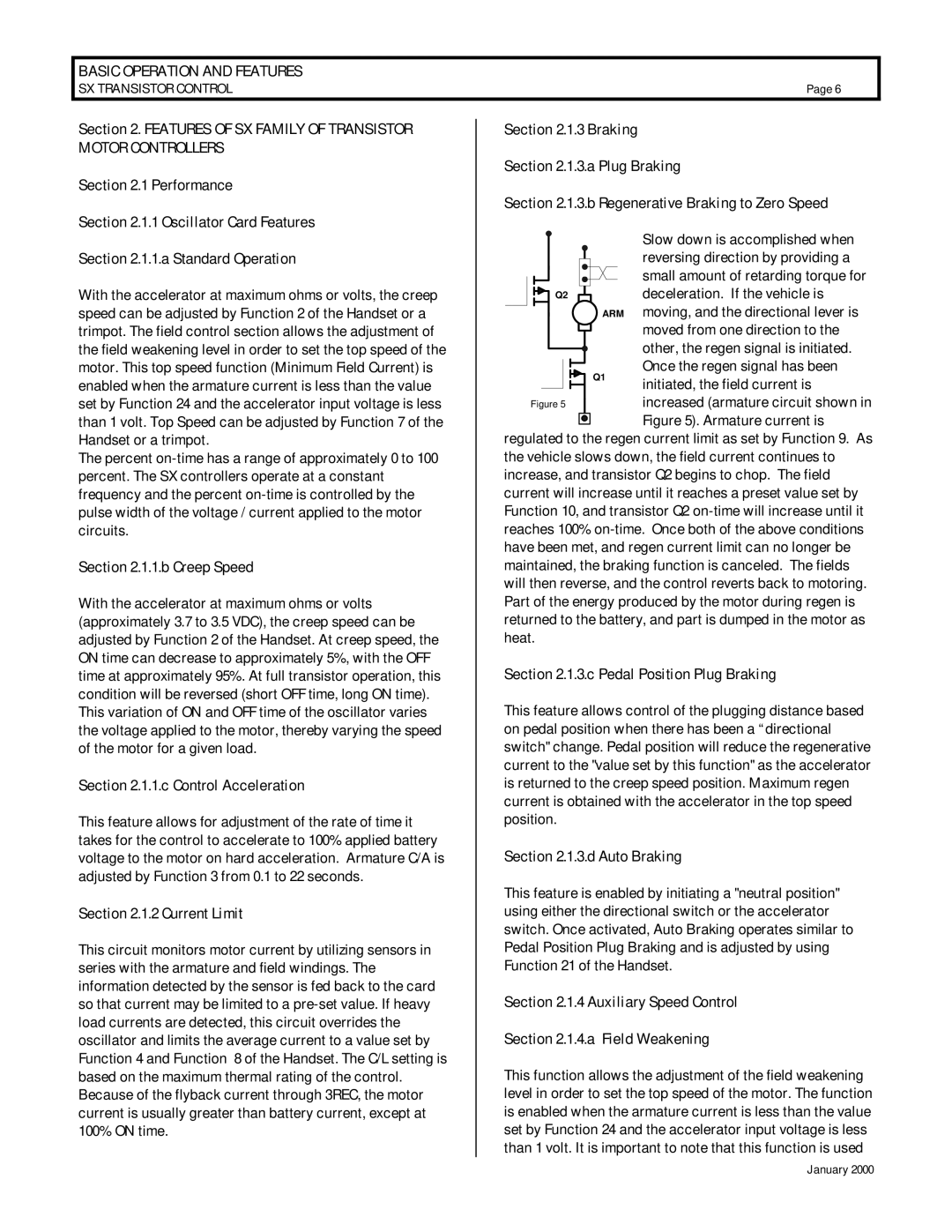
BASIC OPERATION AND FEATURES
SX TRANSISTOR CONTROL | Page 6 |
Section 2. FEATURES OF SX FAMILY OF TRANSISTOR MOTOR CONTROLLERS
Section 2.1 Performance
Section 2.1.1 Oscillator Card Features
Section 2.1.1.a Standard Operation
With the accelerator at maximum ohms or volts, the creep speed can be adjusted by Function 2 of the Handset or a trimpot. The field control section allows the adjustment of the field weakening level in order to set the top speed of the motor. This top speed function (Minimum Field Current) is enabled when the armature current is less than the value set by Function 24 and the accelerator input voltage is less than 1 volt. Top Speed can be adjusted by Function 7 of the Handset or a trimpot.
The percent
Section 2.1.1.b Creep Speed
With the accelerator at maximum ohms or volts (approximately 3.7 to 3.5 VDC), the creep speed can be adjusted by Function 2 of the Handset. At creep speed, the ON time can decrease to approximately 5%, with the OFF time at approximately 95%. At full transistor operation, this condition will be reversed (short OFF time, long ON time). This variation of ON and OFF time of the oscillator varies the voltage applied to the motor, thereby varying the speed of the motor for a given load.
Section 2.1.1.c Control Acceleration
This feature allows for adjustment of the rate of time it takes for the control to accelerate to 100% applied battery voltage to the motor on hard acceleration. Armature C/A is adjusted by Function 3 from 0.1 to 22 seconds.
Section 2.1.2 Current Limit
This circuit monitors motor current by utilizing sensors in series with the armature and field windings. The information detected by the sensor is fed back to the card so that current may be limited to a
Section 2.1.3 Braking
Section 2.1.3.a Plug Braking
Section 2.1.3.b Regenerative Braking to Zero Speed
|
| Slow down is accomplished when |
|
| reversing direction by providing a |
|
| small amount of retarding torque for |
Q2 |
| deceleration. If the vehicle is |
| ARM moving, and the directional lever is | |
|
| moved from one direction to the |
|
| other, the regen signal is initiated. |
| Q1 | Once the regen signal has been |
| initiated, the field current is | |
|
| |
Figure 5 |
| increased (armature circuit shown in |
|
| Figure 5). Armature current is |
regulated to the regen current limit as set by Function 9. As the vehicle slows down, the field current continues to increase, and transistor Q2 begins to chop. The field current will increase until it reaches a preset value set by Function 10, and transistor Q2
Section 2.1.3.c Pedal Position Plug Braking
This feature allows control of the plugging distance based on pedal position when there has been a “directional switch" change. Pedal position will reduce the regenerative current to the "value set by this function" as the accelerator is returned to the creep speed position. Maximum regen current is obtained with the accelerator in the top speed position.
Section 2.1.3.d Auto Braking
This feature is enabled by initiating a "neutral position" using either the directional switch or the accelerator switch. Once activated, Auto Braking operates similar to Pedal Position Plug Braking and is adjusted by using Function 21 of the Handset.
Section 2.1.4 Auxiliary Speed Control
Section 2.1.4.a Field Weakening
This function allows the adjustment of the field weakening level in order to set the top speed of the motor. The function is enabled when the armature current is less than the value set by Function 24 and the accelerator input voltage is less than 1 volt. It is important to note that this function is used
January 2000
